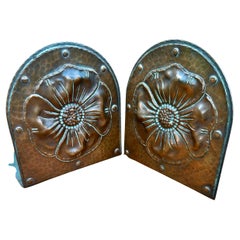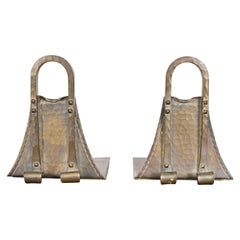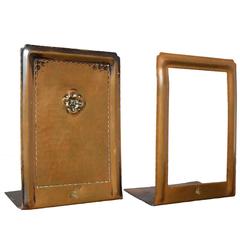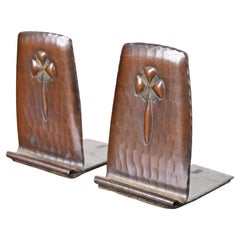Roycroft Copper Bookends
Early 20th Century American Arts and Crafts Bookends
Copper
Early 20th Century American Arts and Crafts Desk Sets
Copper, Brass
Recent Sales
Early 20th Century American Arts and Crafts Bookends
Copper
Early 20th Century American Arts and Crafts Bookends
Copper
Early 20th Century American Arts and Crafts Bookends
Copper
Vintage 1920s American Arts and Crafts Bookends
Copper
20th Century American Art Deco Bookends
Brass, Bronze, Copper, Metal
Early 20th Century American Arts and Crafts Bookends
Copper
Early 20th Century American Arts and Crafts Bookends
Copper
Early 20th Century American Arts and Crafts Bookends
Copper
Early 20th Century American Arts and Crafts Bookends
Brass, Copper
20th Century American Arts and Crafts Bookends
Copper, Metal
Early 20th Century American Arts and Crafts Desk Sets
Copper
Early 20th Century Arts and Crafts Bookends
Copper
Early 20th Century American Arts and Crafts Bookends
Copper
Early 20th Century American Art Deco Bookends
Copper
Early 20th Century American Arts and Crafts Bookends
Copper
Early 20th Century American Arts and Crafts Bookends
Copper
Vintage 1910s American Arts and Crafts More Desk Accessories
20th Century American Bookends
20th Century American Bookends
Roycroft Copper Bookends For Sale on 1stDibs
How Much are Roycroft Copper Bookends?
A Close Look at Arts And Crafts Furniture
Emerging in reaction to industrialization and mass production, the Arts and Crafts movement celebrated handcrafted design as a part of daily life. The history of Arts and Crafts furniture has roots in 1860s England with an emphasis on natural motifs and simple flourishes like mosaics and carvings. This work is characterized by plain construction that showcases the hand of the artisan.
The earliest American Arts and Crafts furniture dates back to the start of the 20th century. Designers working in this style in the United States initially looked to ideas put forth by The Craftsman, a magazine published by Wisconsin native Gustav Stickley, a furniture maker and founder of the Craftsman style. Stickley’s furniture was practical and largely free of ornament. His Craftsman style drew on French Art Nouveau as well as the work he encountered on his travels in England. There, the leading designers of the Arts and Crafts movement included William Morris, who revived historical techniques such as embroidery and printed fabrics in his furnishings, and Charles Voysey, whose minimal approach was in contrast to the ornamentation favored in the Victorian era.
American Arts and Crafts work would come to involve a range of influences unified by an elevation of traditional craftsmanship. The furniture was often built from sturdy woods like oak and mahogany while featuring details such as inlaid metal, tooled leather and ceramic tiles. The style in the United States was led by Stickley, whose clean-lined chairs and benches showcased the grain of the wood, and furniture maker Charles Rohlfs, who was informed by international influences like East Asian and French Art Nouveau design.
Hubs in America included several utopian communities such as Rose Valley in Pennsylvania and the Byrdcliffe Arts and Crafts Colony in New York, where craftspeople made furniture that prioritized function over any decoration. Their work would influence designers and architects including Frank Lloyd Wright, who built some of the most elegant and iconic structures in the United States and likewise embraced a thoughtful use of materials in his furniture.
Find antique Arts and Crafts chairs, tables, cabinets and other authentic period furniture on 1stDibs.
Finding the Right Bookends for You
A good pair of antique, new or vintage bookends will look wonderful in your reading nook. And the need for these trusty home accents has stood the test of time, which means there are many different kinds to suit any design taste or furniture style.
Bookends weren’t created until the 1870s. Serving faithfully in the background, they went unobserved for a while. The authors of the Oxford English Dictionary report that the term “book end” didn’t appear in printed material until 1907. The primary function of bookends is to ensure that your books remain upright in your bookcase, but style and form have taken the lead over the years. Furniture makers have ensured that bookends demand as much attention as the books themselves. Indeed, while competing with carefully curated first editions or rows of colorful spines is no small task, plenty of bookends steal the stage.
If you’re looking to add a dose of intrigue or decorative flourish to your reading room that will be difficult to ignore, stone bookends and metal bookends can take on the appearance of small, provocative sculptures rather than functional accessories to keep your books orderly on your shelves. Depending on what kind of textures you’re thinking of introducing to your home office or study, a pair of brass bookends or a bronze set will pop against your dusty hardcovers and any decorative objects you’ve accumulated while working to style your bookcase. A pair of mid-century modern bookends carved from dark, exotic woods such as teak can also introduce warmth to a home office or study. While teak was a favorite of designers who worked with furniture in the mid-20th century, all manner of wood bookends have emerged over the years, with some woodworkers carving ornate patterns or figures into their pieces.
Bookworms, take note: You can find an extraordinary range of antique, new and vintage bookends for your dazzling book displays and bookshelves today on 1stDibs.



